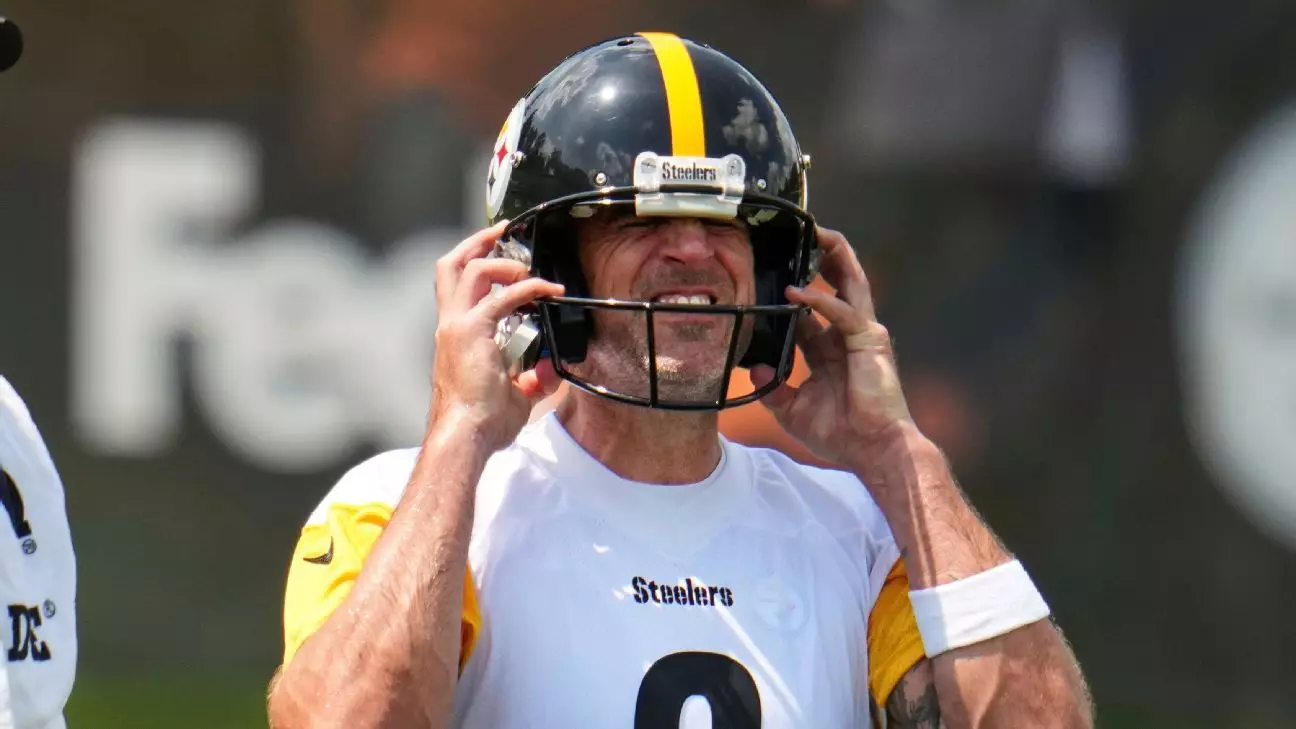Professional sports are often viewed as a pinnacle of human achievement, yet beneath this glamorized surface lies an unrelenting pressure to adapt to evolving standards and regulations. Aaron Rodgers, a seasoned quarterback, embodies this reality, grappling with the unexpected mandate that bans his trusted helmet model, the Schutt Air XP Pro Q11 LTD. This adjustment illuminates a broader truth: even at the highest levels, athletes must constantly recalibrate their equipment and routines under new safety demands. Rodgers’ vocal displeasure underscores how deeply personal and professional identity can be tied to such gear. For him, the helmet isn’t just protection, but a symbol of familiarity forged over two decades.
Yet, this situation also exposes the constraints placed upon athletes by safety mandates. While ensuring player well-being is paramount, the transition to a new helmet that Rodgers describes as “a damn spaceship” reflects the often overlooked friction between progress and tradition. The discomfort he expresses isn’t merely superficial—it affects confidence, performance, and mental focus. This resistance to change highlights how athletes develop a nuanced relationship with their gear, one that extends beyond the functionality to include psychological comfort and trust.
The struggle with helmet substitution raises questions about how sporting organizations balance innovation and athlete autonomy. Rodgers’ candid remarks provide a rare window into the emotional toll of such adjustments. His preference for stability starkly contrasts with regulatory pressures that constantly push for enhanced safety. This tension suggests that safety advancements, while crucial, must be implemented with sensitivity to athletes’ individual needs, acknowledging that their comfort and familiarity are vital for peak performance.
Resilience in the Face of Injury and Uncertainty
While equipment issues dominate headlines, the human element remains central. Rodgers’ minor injury at practice—a step on the calf—serves as a reminder of how fleeting moments can threaten athletes’ physical health. Despite appearing minor, the incident underscores the ongoing risks athletes face, even during routine drills. His quick recovery and return to practice exemplify mental toughness, yet the incident also reveals how unpredictability is an intrinsic part of sports.
Contrast this with rookie quarterback Will Howard’s predicament—a freak finger injury sustained during a seemingly routine exchange. Howard’s experience accentuates how unforeseen accidents can abruptly alter an athlete’s trajectory. His initial optimism swiftly turned to concern as he realized the injury was more severe than a simple jam. His description of the incident as “freak” highlights the randomness that plagues even the most prepared athletes.
Howard’s response demonstrates a resilient mindset. Despite being sidelined and facing uncertain recovery timelines, he emphasizes maintaining readiness. His willingness to accept the injury’s “week-to-week” nature reflects a mature understanding that setbacks are inevitable, yet how one responds defines their resilience. The fact that he views this as just another challenge to overcome reinforces a mindset necessary for long-term success in high-stakes sports.
Moreover, Howard’s acknowledgment of the importance of mental preparedness—staying “day by day”—speaks to a broader truth: physical injuries are as much about mental endurance as they are about recovery. His attitude suggests that embracing adversity with a proactive approach can sometimes be the difference between stagnation and rebound.
Leadership, Adaptation, and the Human Spirit
Both Rodgers’ frustration and Howard’s perseverance exemplify crucial themes in modern sports: adaptability and mental resilience. Rodgers’ vociferous dissatisfaction with his helmet spotlights the importance of athlete participation in equipment decisions and the need for collaborative solutions that safeguard well-being without sacrificing comfort. His candidness may serve as an impetus for leagues and manufacturers to listen more closely to players’ feedback.
On the other hand, Howard’s injury story emphasizes the importance of mental strength in overcoming unforeseen hurdles. Athletes often have little control over accidents or regulatory changes but can control how they respond. His proactive approach—focusing on staying prepared and in shape—reflects a core trait shared by many successful athletes: unwavering commitment despite adversity.
Leadership in this context manifests not only through on-field performance but through resilience in adversity. Rodgers’ willingness to voice his frustrations might catalyze positive change, advocating for better fitting gear without compromising safety standards. Meanwhile, Howard’s calm acceptance and determined attitude highlight how young athletes can develop mental toughness early, equipping themselves to face the unpredictable nature of sports and life.
This narrative also challenges the notion of perfect stability in professional athletics. No matter how seasoned, athletes must navigate abrupt changes—be it equipment, injuries, or team dynamics—and emerge stronger. Their stories reveal that resilience, coupled with adaptability, is what separates fleeting talent from long-lasting greatness. Both Rodgers and Howard exemplify that embracing discomfort and uncertainty is part of the journey towards excellence, even when the path is riddled with unexpected obstacles.


Leave a Reply